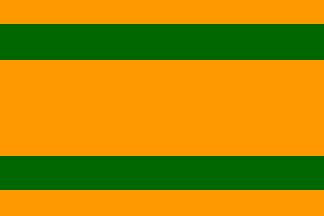
by Thanh-Tâm Le, 28 January 1999

Last modified: 2014-05-29 by zoltán horváth
Keywords: puerto rico | naranjito |
Links: FOTW homepage |
search |
disclaimer and copyright |
write us |
mirrors

by Thanh-Tâm Le, 28 January 1999
See also:
This city of 28,000 inhabitants was founded on my -146th
birthday, December 3, 1824. The flag has an orange background as
a reference to the name of the town, whereas the green stripes
represent the colour of the fields and mountains.
Thanh-Tâm Le, 28 January 1999
I do not know when this flag was designed or appproved , but
doesn't its layout remind the Spanish 1793 Merchant flag?
Santiago Dotor , 28 January 1999
On <netdial.caribe.net>,
there is very clear image of
flag . The flag there looks quite red, instead of
yellow/yellowish red as on the image made by Thanh-Tâm Le.
Jarig Bakker, 3 Febuary 2000
From <www.ngw.nl>:
"The cross in the first quarter is the cross of St. Michael,
the patron saint of the town. The orb symbolises divine
sovereignty and the lilies are the symbol of St. Anthony of
Padua, the other local saint. The two bars are taken from the
arms of the arms of the Guadiana family. The orange tree in the
fourth quarter is canting, as the name of the town means 'small
orange tree'."
Nelson Román, 8 July 2004
It consists of a red cross that is symbol of San Miguel de
Arcángel, Patron of Naranjito. The globe with the cross
symbolizes the power and sovereignty of God. The gold and red
stripes that appear in the second and third quarters, constitute
the primitive baton of the Guafiana lineage. The lily twigs are a
tribute of San Antonio de Padua, confessor and doctor of the
Church. The orange tree represents the small tree that gave the
town's name, Naranjito. The crown is symbol of moral unit of the
town.
Nelson Román, 27 July 2004
The saint patron is Archangel St. Michael. Naranjito has 3
important hills. The bigger hill is named Archangel St. Michael
and is represented by the red cross alone because is the saint
patron too . The second one is named Saint Christofer and it's
represented by the globe with the cross that is a icon of this
saint and this icon symbolizes the power and sovereignty of God.
The white lily twigs (azucenas in spanish) are a attributeribute
of San Antonio de Padua, confessor and doctor of the Church. The
third important hill of Naranjito is named San Antonio de
Padua.The white lily twigs is a traditional attribute to San
Antonio de Padua.
Nelson Román, 28 July 2004